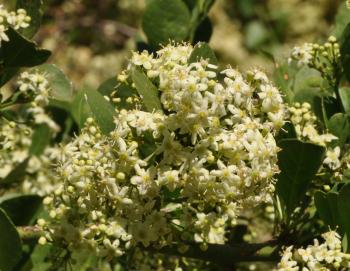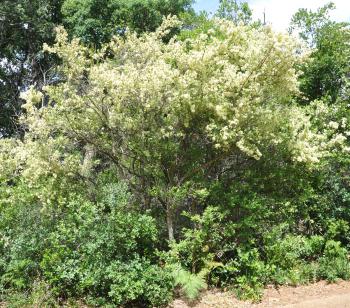Gymnosporia buxifolia
Gymnosporia buxifolia (L.) Szyszyl.
Family: Celastraceae
Common names: spikethorn, common spikethorn, stinking spike-thorn (Eng.); gewone pendoring, pendoring, stinkdoring, lemoendoring (Afr.); ingqwangane, ubangalala, usala (isiZulu); mnqaqoba, umhlongwe (isiXhosa); sephatwa (Northern Sotho); motlhonu (Setswana); sihlangu lesimnyama (siSwati) ; tshiphandwa (Tshivenda)
SA Tree No: 399
Introduction
Gymnosporia buxifolia is a very showy plant when in flower and can grow into an interesting and shapely small tree over time. It can be pruned to form a dense, spiny, evergreen hedge. It is a very cold- and drought-hardy plant, so it will be good in areas prone to these conditions.

Description
Description
Gymnosporia buxifolia takes the form of a large shrub of about 3 m high, or a small, weather-beaten, evergreen tree, up to 7 m tall. It has simple variable leaves that are obovate with a rounded apex, sometimes notched, and a wedge-shaped base. The margin is unequally toothed towards the tips. Leaves are alternate or clustered in arrangement. The bark is light brown and smooth, becoming very dark, rough, corky and fissured as the tree ages. It is armed with sharp, slender to robust spines, about 3.5–100 mm long, on the branches.
The small, white to cream-coloured flowers are in dense, many-flowered clusters all along the branches. They have an unpleasant foetid to sickly sweet smell that attracts many insects. G. buxifolia in flower is very showy and its flowering months are from July to April, mainly in spring to early summer (August to November).
Fruit capsules are rounded, wrinkled and leathery, white to greyish brown when mature, to 7 mm in diameter, containing 1–4 seeds that are partly covered by a yellow aril.

Conservation Status
Status
According to the Red List of South African Plants, accessed on 30 October 2015, the conservation status of Gymnosporia buxifolia is Least Concern (LC).
Distribution and habitat
Distribution description
Gymnosporia buxifolia is widespread in southern Africa, occurring in the Northern Cape, Western Cape, Eastern Cape, Free State, Gauteng, Limpopo, North West, Mpumalanga and KwaZulu-Natal, and in Lesotho, Botswana, Swaziland and Namibia, and into tropical Africa.
Its natural habitat is in grasslands, fynbos, Nama-karoo, forests, thickets and savanna-bushveld. It occurs on hillsides, dry slopes of valleys, sometimes in riverbeds, often on termite mounds and it is often found as undergrowth to taller trees.
Derivation of name and historical aspects
History
The name Gymnosporia comes from the Greek, gymno, which means 'naked' and sporia, which means 'seed', therefore ‘naked seed’, in reference to the seeds that remain attached and exposed after the fruit has opened. The name buxifolia means, ‘with leaves like those of Buxus sempervirens’, the common box.
Ecology
Ecology
Gymnosporia buxifolia flowers have a sickly sweet to foetid fragrance which attracts flies and other insects. Insect-eating birds will forage for insects in the foliage and eat insects attracted to the flowers; it also provides nesting sites for birds and shelter for other animals.

Uses
Use
Gymnosporia buxifolia with its strong, sharp spines makes a very good screen or hedge for protection. It is also a good plant for wildlife-friendly gardens, as it attracts a variety of insects and birds to the garden. It may be grown as a backdrop to the mixed border, and is showy in flower.
Gymnosporia buxifolia is used in traditional medicine for pleurisy, diarrhoea, as a snakebite remedy, chest colds and coughs. Use with caution as this plant is reputed to be toxic. The wood is fine-grained, heavy, hard and strong and suitable for tool handles; engraving and large enough pieces turn well when making furniture. However, the sap is considered slightly toxic, and tool handles made from this wood may irritate a sensitive skin.
Growing Gymnosporia buxifolia
Grow
Gymnosporia buxifolia can be used as a barrier plant, boundary plant, hedge or screening plant, as well as a bonsai. Prune to shape, and to increase branching, and trim to create a dense, impenetrable hedge. It is frost hardy and drought resistant and is a tough pioneer species, useful on exposed sites and to create shade for slower-growing trees. It is also suitable for coastal gardens. It is ideal for a wildlife-friendly garden or in a natural garden, as it brings wildlife into the garden, attracting flies, bees, butterflies and other insects, that further attract birds. The smell of the flowers can be quite unpleasant and overpowering, so do not plant it too close to your house; it flowers (and smells) for a few weeks to a month in the year.
Gymnosporia buxifolia should be planted in prepared holes with some compost and bonemeal added, and mulched well. Water regularly until well established, then reduce water until the plant is thoroughly hardened and water wise. Unless you require fast growth, this shrub will need no more attention, other than an occasional pruning if necessary; it is a low-maintenance plant.
Collect the seeds from the capsules after they split open. Sow seeds immediately, or store in a cool dry place and sow in spring or early summer.
References
- Boon, Richard. 2010. Pooley's trees of eastern South Africa, a complete guide. Flora & Fauna Publications Trust, Durban.
- Grant, R. & Thomas, V.2002. Sappi tree spotting, Highveld and the Drakensburg. Johannesburg. Jacana Publishers.
- Hutchings, A., Scott, A.H., Lewis, G. & Cunningham, A.B. 1996. Zulu medicinal plants: an inventory. University of Natal Press, Pietermaritzburg.
- Van Wyk, B. & Van Wyk, P. 1997. Field guide to trees of southern Africa. Struik, Cape Town.
- Van Wyk, B., Van Wyk, P. & Van Wyk, B.-E. 2000. Photographic guide to trees of South Africa. Struik, Cape Town.
Credits
Sameer Khan & Bathabile Ndlovu
KwaZulu-Natal National Botanical Garden
November 2015
Plant Attributes:
Plant Type: Shrub, Tree
SA Distribution: Eastern Cape, Free State, Gauteng, KwaZulu-Natal, Limpopo, Mpumalanga, North West, Northern Cape, Western Cape
Soil type: Sandy, Loam
Flowering season: Early Summer
PH: Acid, Neutral
Flower colour: White, Cream
Aspect: Full Sun, Morning Sun (Semi Shade), Afternoon Sun (Semi Shade)
Gardening skill: Easy
Special Features:
Horticultural zones











Rate this article
Article well written and informative
Rate this plant
Is this an interesting plant?
Login to add your Comment
Back to topNot registered yet? Click here to register.